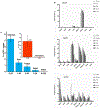Pharmacokinetics of nanotechnology-based formulations in pediatric populations
- PMID: 31494124
- PMCID: PMC6893132
- DOI: 10.1016/j.addr.2019.08.008
Pharmacokinetics of nanotechnology-based formulations in pediatric populations
Abstract
The development of therapeutics for pediatric use has advanced in the last few decades. However, off-label use of adult medications in pediatrics remains a significant clinical problem. Furthermore, the development of therapeutics for pediatrics is challenged by the lack of pharmacokinetic (PK) data in the pediatric population. To promote the development of therapeutics for pediatrics, the United States Pediatric Formulation Initiative recommended the investigation of nanotechnology-based delivery systems. Therefore, in this review, we provided comprehensive information on the PK of nanotechnology-based formulations from preclinical and clinical studies in pediatrics. Specifically, we discuss the relationship between formulation parameters of nanoformulations and PK of the encapsulated drug in the context of pediatrics. We review nanoformulations that include dendrimers, liposomes, polymeric long-acting injectables (LAIs), nanocrystals, inorganic nanoparticles, polymeric micelles, and protein nanoparticles. In addition, we describe the importance and need of PK modeling and simulation approaches used in predicting PK of nanoformulations for pediatric applications.
Keywords: Half-life; Maturation; Modeling and simulation; Nanotechnology; Ontogeny; Pediatrics; Pharmacokinetics.
Copyright © 2019 Elsevier B.V. All rights reserved.
Figures


Similar articles
-
The Clinical Translation of Organic Nanomaterials for Cancer Therapy: A Focus on Polymeric Nanoparticles, Micelles, Liposomes and Exosomes.Curr Med Chem. 2018;25(34):4224-4268. doi: 10.2174/0929867324666170830113755. Curr Med Chem. 2018. PMID: 28875844 Review.
-
Computational approaches to the rational design of nanoemulsions, polymeric micelles, and dendrimers for drug delivery.Nanomedicine. 2012 Jan;8(1):20-36. doi: 10.1016/j.nano.2011.05.006. Epub 2011 May 25. Nanomedicine. 2012. PMID: 21669300 Review.
-
Oral bioavailability: issues and solutions via nanoformulations.Clin Pharmacokinet. 2015 Apr;54(4):325-57. doi: 10.1007/s40262-015-0242-x. Clin Pharmacokinet. 2015. PMID: 25666353 Review.
-
An Update on Biomedical Application of Nanotechnology for Alzheimer's Disease Diagnosis and Therapy.Drug Res (Stuttg). 2016 Nov;66(11):580-586. doi: 10.1055/s-0042-112811. Epub 2016 Oct 4. Drug Res (Stuttg). 2016. PMID: 27701713 Review.
-
Role of nanotechnology in pharmaceutical product development.J Pharm Sci. 2007 Oct;96(10):2547-65. doi: 10.1002/jps.20875. J Pharm Sci. 2007. PMID: 17688284 Review.
Cited by
-
Polymeric and Lipid Nanoparticles: Which Applications in Pediatrics?Pharmaceutics. 2021 May 7;13(5):670. doi: 10.3390/pharmaceutics13050670. Pharmaceutics. 2021. PMID: 34066953 Free PMC article. Review.
-
Nanomedicine Therapies for Pediatric Diseases.Wiley Interdiscip Rev Nanomed Nanobiotechnol. 2024 Sep-Oct;16(5):e1996. doi: 10.1002/wnan.1996. Wiley Interdiscip Rev Nanomed Nanobiotechnol. 2024. PMID: 39420230 Free PMC article. Review.
-
Biomembrane-Based Nanostructure- and Microstructure-Loaded Hydrogels for Promoting Chronic Wound Healing.Int J Nanomedicine. 2023 Jan 19;18:385-411. doi: 10.2147/IJN.S387382. eCollection 2023. Int J Nanomedicine. 2023. PMID: 36703725 Free PMC article. Review.
-
Exploring the Potential of Nanotechnology in Pediatric Healthcare: Advances, Challenges, and Future Directions.Pharmaceutics. 2023 May 24;15(6):1583. doi: 10.3390/pharmaceutics15061583. Pharmaceutics. 2023. PMID: 37376032 Free PMC article. Review.
-
Development of nanoparticle-based orodispersible palatable pediatric formulations.Int J Pharm. 2021 Mar 1;596:120206. doi: 10.1016/j.ijpharm.2021.120206. Epub 2021 Jan 22. Int J Pharm. 2021. PMID: 33493595 Free PMC article.
References
-
- Turner MA, Catapano M, Hirschfeld S, Giaquinto C, Global Research in P, Paediatric drug development: the impact of evolving regulations, Adv Drug Deliv Rev, 73 (2014) 2–13. - PubMed
Publication types
MeSH terms
Substances
Grants and funding
LinkOut - more resources
Full Text Sources

